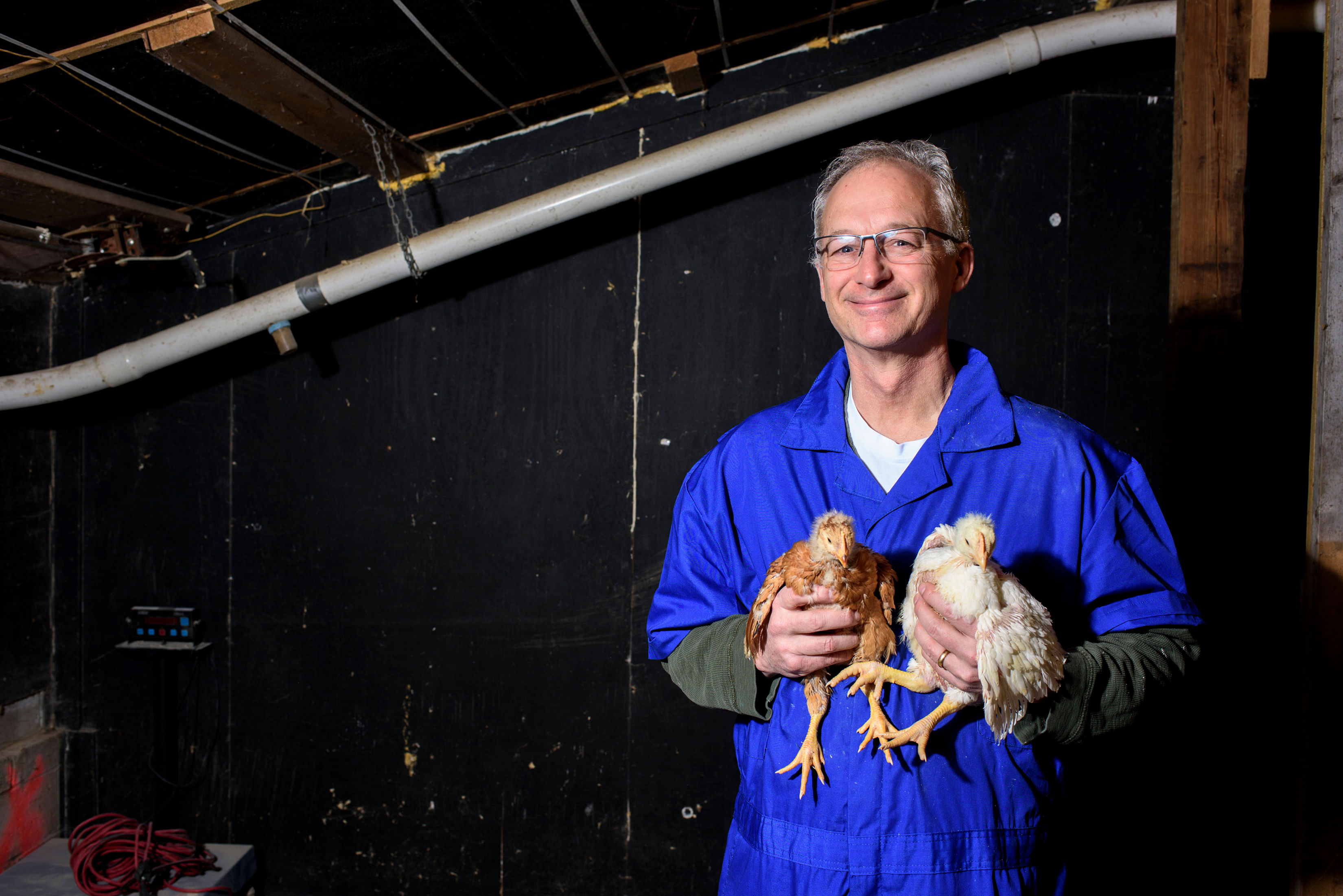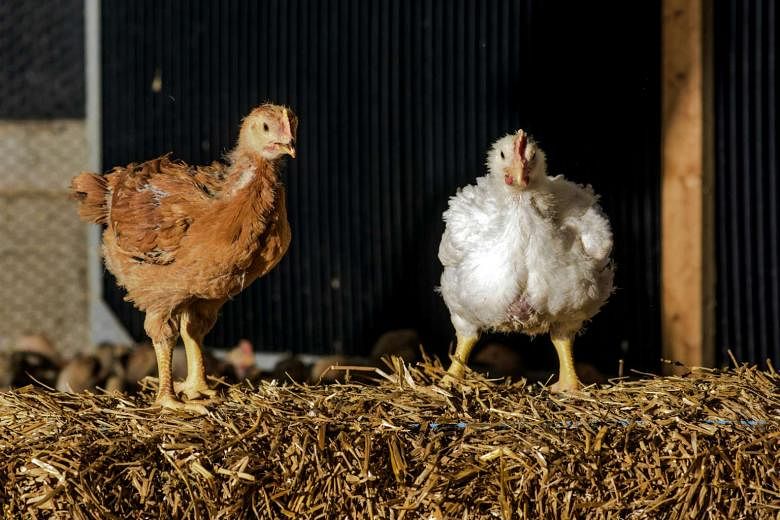SALISBURY, MARYLAND (NYTimes) - The chickens in one pen were, for the most part, doing what they usually do toward the end of their lives on a factory farm: resting on the floor, attacking the feeding pan, getting big fast.
But in the next pen over, smaller, leaner birds of the same age ran around, raising a ruckus as they climbed on haystacks, perched on roosts and gave themselves dirt baths.
"We're going to have to come up with a sturdier water line," said Dr Bruce Stewart-Brown, a veterinarian and senior vice president of Perdue Farms, as he watched two of them swing the tube that supplies water to the pen.
The frisky birds and their more sedentary neighbours here in a barn on the Delmarva Peninsula are part of an experiment that could help change the way Americans eat, and think about, poultry.
Perdue Farms, one of the country's largest chicken producers, has been raising what are known as slow-growth chickens side by side with the breeds that have made the company so successful. The new birds, a variety known as Redbro, take 25 per cent longer, on average, to mature than their conventional cousins, and so are more expensive to raise.

Perdue is trying to find just the right slow-growth breed, and it has a strong incentive: A fast-growing cohort of companies that buy vast quantities of poultry, including Whole Foods Market and Panera Bread, are demanding meat from slow-growth chickens, contending that giving birds more time to grow before slaughter will give them a healthier, happier life - and produce better-tasting meat.
"We want to get back to a place where people don't have to put a marinade on their chicken to make it taste like something," said Theo Weening, who oversees meat purchasing for Whole Foods and recalls how his mother bought chicken by breed in the Netherlands, where he grew up.
Weening is realistic, though. "We have to figure out how can we make this happen so we're not ending up with a chicken nobody can afford," he said.
That is the big challenge for chicken producers. Stewart-Brown, of Perdue, said it cost about 30 per cent more to feed the Redbro birds; the expense can run even higher for other slow-growth breeds, some of which can take as much as twice as long to reach full weight as conventional birds.
Differences in their musculature may cut into a producer's profits as well. The Redbro chickens, for instance, have skinnier wings than their conventional cousins, and wings command a high price by weight.
"I don't know that we'll be selling any of these kinds of birds in pieces," Stewart-Brown said.
Consumers would also have to accept some trade-offs: While the new chickens have a fuller flavour, their meat tends to be distributed differently over the body, with more generous thighs and smaller breasts than the chicken most Americans are used to.
Perdue has been testing different breeds for about the last 18 months, using insights it has gained since it acquired Petaluma Poultry, a boutique business that produces slow-growth, pastured and organic chickens. Perdue expects to start selling a slow-growth chicken in grocery stores sometime in the next few years.
There are already several smaller companies selling such chickens, including Emmer & Co., Pitman Family Farms, White Oak Pastures and Crystal Lake Farms, which was bought in February by the meat supply company West Liberty Foods.
But Perdue appears to be the first, and so far the only, major chicken supplier to test slow-growth birds. The other four big producers have expressed little interest, though Tyson Foods, the country's largest chicken producer, owns Cobb-Vantress, one of three large genetics companies that maintain a sort of library of bird types that they continue to tweak in response to demand from chicken producers. (It sells eggs or chicks with the genetic components for slower-growing chickens.) Last year, Bon Appétit Management, which supplies many college kitchens and runs a chain of restaurants, announced that by 2024 it would sell meat only from slow-growth chickens.
"The reaction I got from the mainstream chicken suppliers at that time was kind of deadpan," said Maisie Ganzler, who is Bon Appétit's vice president for strategy. "They essentially said: 'Well, it's interesting that you want to go in that direction. We don't.'" Since then, Bon Appétit has been joined by companies like the Compass Group, which owns Bon Appétit; its competitor, Aramark; Nestlé; Starbucks; Chipotle Mexican Grill; and, on Friday, Subway, the nation's largest fast-food chain.
The Global Animal Partnership, which sets standards for the welfare of animals raised for meat, said that by 2024 it would give animal-welfare certifications only to slow-growth chickens, a move that would affect some 270 million broilers, or about 3 per cent of the nation's flock.
The chicken industry, fearing that the string of announcements might force the kind of rapid changes that snowballed in the egg business after companies demanded eggs from cage-free birds, quickly produced a report that predicted dire consequences if there was a similar move to produce slow-growth chicken. Compiled by the animal medicine division of Eli Lilly & Co., it estimated that a shift to slow-growth production would require more land, water and feed. The industry also contends that without the efficiency of today's chickens, which pack on more pounds with less feed over fewer and fewer days, the world will be unable to feed its growing population.
Today's conventional broiler chickens have been bred over the years to produce the most amount of meat in as short a time as possible, reducing a farmer's costs and increasing profits. In 1935, the average broiler chicken reached the slaughter-ready weight of 2.86 pounds in 98 days, according to the National Chicken Council. Today's broilers are an average of 6.18 pounds (2.8kg) at the time of slaughter, when they are about 47 days old.
Food is the largest cost for chicken producers, and the Redbro birds don't eat as much as the two conventional chickens Perdue is using for comparison, Stewart-Brown said. "They're bred to put on as much weight as possible in as little time, so they have quite an appetite," he said of the conventional chickens.
But because the Redbros take longer to mature and are far more active than the conventional birds, they will eat more to produce each pound of meat, he said. And because they are more active, they need more space, which Stewart-Brown estimated would mean limiting the population of a chicken barn to 22,000, or about 3,000 fewer birds than is standard with today's breeds.
The Redbro birds stand taller and drink less water - "I like that," Stewart-Brown said. Their higher activity levels also help aerate the litter that covers the floor of chicken houses; drier pens, he said, are less likely to create food-safety problems.
Conventional birds need larger feet and shorter legs to support the fast development of their musculature, which is the meat. Their muscles grow faster than their skeletons, so by the time they are slaughtered, they cannot move around easily for long and end up nesting in litter, which can lead to sores on their sternums, and foot and leg problems.
"The breeding companies have done a great job of giving their customers, the chicken producers, what they want, which has been fast growth with lots of muscle tissue," said Anne Malleau, the executive director of the Global Animal Partnership. The group is working on a protocol for assessing genetics so that it can then establish a list of breeds or standards that will qualify as slow-growth.
Mike Cockrell, the chief financial officer at Sanderson Farms, a large chicken producer, noted that it's already possible to produce a conventional bird with a longer life span. Sanderson and other chicken companies produce what are called "big birds," conventional chickens that weigh roughly 9 pounds (4kg) when slaughtered at about 56 days.
"So is that a slow-growth chicken?" Cockrell asked. "Of course we'll respond to customers, but I'm not really sure we know what we're talking about here." In marketing slow-growth chickens, Perdue and others will have to make consumers understand why they are paying a higher price. Emmer, for instance, sells two 3.25 pound (1.48kg)birds for US$59 (S$82.30) on its website, while the suggested retail price of a Sonoma Red (from Perdue's Petaluma Poultry) that weighs 4 pounds (1.81kg) is US$16 (S$22.32).
Shoppers often say they want better welfare for the animals they eat, then balk at the cost that adds to the price of a pork chop or chicken breast. Malleau said she believed, however, that a growing number of consumers were diversifying the proteins they ate.
"As a society, we're going to be making different choices than we did 20 years when it comes to protein in our diets, and in some ways, this move to slow-growth chicken is a gamble on that," she said. "We'll see how it turns out."

